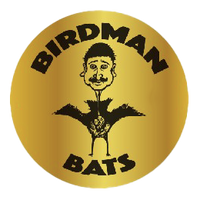Frequently Asked Questions
We strive for a two to three week production time on all domestic orders and offer a rush service that knocks it down to one week. International shipping times vary due to a wide range of factors. Please contact us directly for further information. We also offer multiple shipping options.
The black dot you see on the handle is in fact a drop of ink that we apply to each adult bat. After the ink spreads up and down the grain, we use a measuring device (provided by MLB's Office of the Commissioner) to ensure proper "slope of grain" on that particular piece of wood. The "ink dot test" has drastically helped in reducing the amount of breakage with birch and maple bats in the professional ranks. Think of it as a method of quality control.
Good question! In short, there is no clear-cut answer. There are benefits to using light bats; there are benefits to swinging heavier ones. The same can be said about the length. With that in mind, the "right" bat size is probably more of a question about what size feels right! We are always available to help guide you toward a selection - feel free to reach out to us anytime!
We’ve heard folklorish tales of birch “feeling like a wet newspaper," but rest assured, we go through a few extra steps to provide you bomb-dropping birch power right out of the box. Yes, it’s perfectly natural for your birch bat to dent a bit (especially in the beginning), but fear not: birch condenses and hardens over time with each laser you hit. Speaking of folklore, we've also heard tales of birch bats being so durable that they've lasted an entire season!
Our paints are opaque, meaning the color is solid when applied to the bats. Our hand-mixed dyes are more transparent, allowing the grains to show through the color. The dyes are always similar but will vary slightly with each piece of wood, giving you that “one of a kind” feeling like a piece of art.
Again, there are benefits and downsides to both cupped and un-cupped bats. Cupping takes weight off the end, making for a more balanced, less "top-heavy" bat. More importantly, however, cupping permits us to use a denser piece of wood in the initial cut. If you're a player that habitually hits the ball off the end of the bat, however, an un-cupped bat might be best for you!
According to Major League Baseball, "low density" maple bats have a higher probability of breaking than their counterparts. Additionally, tests have shown that maple bats with less density have a lower "impact strength," possibly leading to lessened exit velocities. Due to its fibrous nature and higher impact strength, birch is not significantly affected by wood density.
For birch and maple, always hit with the label up (or down). Doing so will allow you to hit with the "face grains" of the bat, giving you the most power and durability.
As soon as humanly possible! If your goal is to play in the big leagues, you're going to have to become proficient with wood. Even if you're using metal in games, wood bats are a great training tool as they teach you how to find a smaller sweet spot.
Use this text to answer questions in as much detail as possible for your customers.
Yes
Yes. First and foremost, bats are meant for hitting baseballs and baseballs only. Additionally, being that wood is, well, wood, humidity and extreme, rapid changes in temperature can be detrimental. A safe play is to keep your bats indoors or in a controlled climate. That will ensure each bat lives its best life.
Birch and maple are both great options. They share a commonality in that each is a diffused-porous (closed grain) hardwood, meaning that neither wears out through repeated use like ash bats.
Our maple bats are manufactured from the best maple on the planet - they are stiff and hard as a rock. If you live on the barrel, maple will last and last. Maple, however, tends to become more brittle in lighter weights and lower density models.
While birch is scientifically similar to maple, it does have longer fibers, allowing for more flex upon impact. Essentially, this added flex provides more room for error for the hitter. Birch does sacrifice some of the hardness that maple offers, but many will argue that it’s a non-factor. If you like big barrels and lighter bats, birch is a no-brainer. They maintain their durability even with lower density models.
All bats are weighted in reference to their length. A "minus three" (-3) simply means that the bat weighs three ounces lighter than its length in inches.



